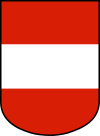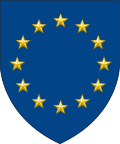Austrian Armed Forces
The Austrian Armed Forces (German: Bundesheer, lit. 'Federal Army') are the combined military forces of the Republic of Austria and the main military organisation responsible for national defence.
| Austrian Armed Forces | |
|---|---|
| Bundesheer | |
 Insignia of the Bundesheer | |
| Founded | 18 March 1920 |
| Current form | 15 May 1955 |
| Service branches |
|
| Headquarters | Rossauer Barracks, Vienna |
| Website | www |
| Leadership | |
| Commander-in-chief | President Van der Bellen |
| Minister of Defense | Klaudia Tanner |
| Chief of the General Staff | Gen Robert Brieger |
| Manpower | |
| Military age | 17 |
| Conscription | 6 months |
| Available for military service | 1,941,110 males, age 16-49, 1,910,434 females, age 16-49 |
| Fit for military service | 1,579,862 males, age 16-49, 1,554,130 females, age 16-49 |
| Reaching military age annually | 48,108 males, 45,752 females |
| Active personnel | 21,200 (2018)[1] |
| Reserve personnel | 950,000, of which 157,900 joint structured (2018)[1] |
| Deployed personnel | 1,099 (2018)[2] |
| Expenditures | |
| Budget | €2.85 billion ($3.38 billion) (2018)[1] |
| Percent of GDP | 0.74% (2018)[1] |
| Industry | |
| Domestic suppliers | Steyr Mannlicher Glock Ges.m.b.H. |
| Foreign suppliers | |
| Related articles | |
| History | Military history of Austria Austro-Hungarian Army |
| Ranks | Ranks of the Austrian Bundesheer |
It includes following branches: the Joint Forces (Streitkräfteführungskommando), which consists of the Land Forces (Landstreitkräfte), Air Forces (Luftstreitkräfte), International Missions (Internationale Einsätze) and Special Forces (Spezialeinsatzkräfte), next to Mission Support (Kommando Einsatzunterstützung) and Joint Command Support Centre (Führungsunterstützungszentrum).[3]
The military consists of 21,200 active-duty personnel and 950,000 reservists, of which 157,900 are joint-structured and 130,200 unstructured.[1] The military budget is 0.74% of national GDP or €2.85 billion, which includes military pensions.[1]
Austria, a landlocked country, has no navy; from 1958 to 2006 however the Austrian army operated a naval squadron of patrol boats on the River Danube. That duty has been assumed by the Bundespolizei (Federal Police).
History
Between 1918 and 1920, the Austrian semi-regular army was called Volkswehr ("People's Defence"), and fought against Yugoslavian army units occupying parts of Carinthia. It has been known as "Bundesheer" since then, except when Austria was a part of Nazi Germany (1938–1945; see Anschluss). The Austrian Army did develop a defence plan in 1938 against Germany, but politics prevented it from being implemented.
World War II role of the "Bundesheer":
- Elements of Austrian Army became 9th Panzer Division (Wehrmacht)
- Elements of Austrian Army became 44th Infantry Division (Wehrmacht)
- 4th Austrian Division became the 45th Infantry Division (Wehrmacht)
In 1955, Austria issued its Declaration of Neutrality, meaning that it would never join a military alliance. The Austrian Armed Forces' main purpose since then has been the protection of Austria's neutrality. Its relationship with NATO is limited to the Partnership for Peace program.[4]
With the end of the Cold War, the Austrian military have increasingly assisted the border police in controlling the influx of undocumented migrants through Austrian borders. The war in the neighbouring Balkans resulted in the lifting of the restrictions on the range of weaponry of the Austrian military that had been imposed by the Austrian State Treaty.
 Troops entering Klagenfurt after a manoeuvre in Carinthia (September, 1929)
Troops entering Klagenfurt after a manoeuvre in Carinthia (September, 1929) Austrian Gebirgsjäger in 1930
Austrian Gebirgsjäger in 1930 Austrian Armed Forces celebrating their 10th anniversary in March 1930 at the Viennese Heldenplatz
Austrian Armed Forces celebrating their 10th anniversary in March 1930 at the Viennese Heldenplatz Austrian mountain artillerymen during a manoeuvre in Tyrol
Austrian mountain artillerymen during a manoeuvre in Tyrol New "Standarten" (flags) of Austrian Army units being consecrated by a Catholic priest in Mattersburg, Burgenland
New "Standarten" (flags) of Austrian Army units being consecrated by a Catholic priest in Mattersburg, Burgenland Engineers building a bridge across the Danube during a manoeuvre in 1931
Engineers building a bridge across the Danube during a manoeuvre in 1931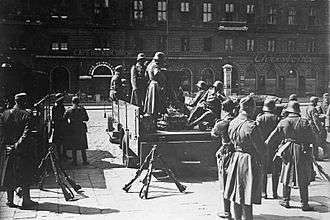 Soldiers of the Austrian Army in Vienna, during the Austrian Civil War in 1934
Soldiers of the Austrian Army in Vienna, during the Austrian Civil War in 1934.jpg) Troops of predecessor organisation B-Gendarmerie training with M1 Garands during the 1950s
Troops of predecessor organisation B-Gendarmerie training with M1 Garands during the 1950s
Mission
The main constitutional tasks of today's Austrian military are:
- to protect the constitutionally established institutions and the population's democratic freedoms.
- to maintain order and security inside the country.
- to render assistance in the case of natural catastrophes and disasters of exceptional magnitude.
Organization

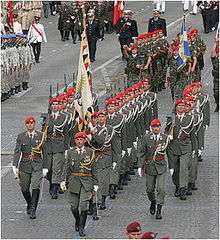
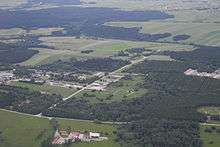
.jpg)
Under the constitution, the President is the commander-in-chief of the armed forces. In reality, the Chancellor has the decision-making authority, exercised through the Minister for National Defence. The Chancellor also chairs the National Defence Council, which has as its members a vice-chairman, the minister for national defence, an appointee of this minister, the Chief of the General Staff, and a parliamentary representative. The minister for national defence, acting in co-operation with the minister for interior, coordinates the work of the four major committees under the National Defence Council: the Military Defence Committee; the Civil Defence Committee; the Economic Defence Committee; and the Psychological Defence Committee. The Chief of the General Staff acts as the senior military adviser to the Minister for National Defence, assists the minister in the exercise of his authority, and, as the head of the general staff, is responsible for planning. However, the army commander exercises direct operational control of the Bundesheer in both peacetime and wartime.
Article 79 of the constitution, as amended in 1985, states that the Army is entrusted with the military defence of the country. Insofar as the legally constituted civil authority requests its co-operation, the army is further charged with protecting constitutional institutions and their capacity to act, as well as the democratic freedoms of the inhabitants; maintaining order and security in the interior; and rendering aid in disasters and mishaps of extraordinary scope. In administering the armed forces, the Ministry for National Defence is organized into four principal sections and the inspectorate general: Section I deals with legal and legislative matters; Section II handles personnel and recruitment matters, including discipline and grievances; Section III is concerned with troop command, schools, and other facilities, and it also comprises departments G-1 through G-5 as well as a separate department for air operations; and Section IV deals with procurement and supply, quartermaster matters, armaments, and ordnance (see fig. 12).
The general troop inspectorate is a separate section of the ministry with responsibility for co-ordination and fulfilment of the missions of the armed forces. It encompasses a general staff department, an attaché department, and planning and inspection groups.
The armed forces consist solely of the army, of which the air force is considered a constituent part. In 1993, the total active complement of the armed forces was 52,000, of whom 20,000 to 30,000 were conscripts undergoing training of six to eight months. The army had 46,000 personnel on active duty (including an estimated 19,500 conscripts), and the air force had 6,000 personnel (2,400 conscripts).[5]
Army
Cold War structure
Under the area defence strategy, which had determined the army's organizational structure until 1993, the army was divided into three principal elements: the standing alert force (Bereitschaftstruppe) of active units, including the air division; the mobile militia (Mobile Landwehr), organized as eight mechanized reserve brigades to be deployed to key danger spots in the event of mobilization; and the stationary militia (Raumgebundene Landwehr) of twenty-six reserve infantry regiments organized for territorial defence. Both the mobile militia and the stationary militia were brought up to strength only in times of mobilization or during periods allotted for refresher training, usually three weeks in June. Training of conscripts was conducted by twenty-eight training and equipment-holding regiments (Landwehrstammregimenter). On mobilization, these regiments would disband, with their cadre reassigned to lead reserve units or form replacement regiments and battalions.
At the army level were a headquarters, guard, and special forces battalions and an artillery battalion at cadre strength. Two corps headquarters, one in the east at Graz and one in the west at Salzburg, would, on mobilization, command the provincially organized units in their respective zones. Each corps included artillery, antitank, antiaircraft, and engineering battalions, and a logistics regiment, all on a cadre basis.
Each of the nine provincial military commands supervised the training and maintenance activities of their training and equipment-holding regiments. On mobilization, these nine commands would convert to a divisional headquarters commanding mobile militia, stationary militia, and other independent units.
The only active units immediately available in an emergency were those of the standing alert force of some 15,000 career soldiers supplemented by eight-month conscripts. The force was organized as a mechanized division consisting of three armored infantry brigades. Each brigade was composed of one tank battalion, one mechanized infantry battalion, and one self-propelled artillery battalion. Two of the brigades had antitank battalions equipped with self-propelled weapons. The divisional headquarters was at Baden near Vienna; the three brigades were based in separate locations, also in the northeast of the country.
Post-Cold War structure
The New Army Structure—the reorganization plan announced in late 1991 and scheduled to be in place sometime in 1995—replaces the previous two-corps structure with one of three corps. The new corps is headquartered at Baden, with responsibility for the two northeastern provinces of Lower Austria and Upper Austria. Army headquarters will be eliminated, as will the divisional structure for the three standing brigades. The three corps—in effect, regional commands—will be directly subordinate to the general troop inspector. The three mechanized brigades will be placed directly under the new Third Corps at Baden, although in the future one brigade may be assigned to each of the three corps. The mobile militia will be reduced from eight to six mechanized brigades. Each of the nine provincial commands will have at least one militia regiment of two to six battalions as well as local defence companies.
Total personnel strength—both standing forces and reserves—is to be materially contracted under the new plan. The fully mobilized army will decline in strength from 200,000 to 120,000. The standing alert force will be reduced from 15,000 to 10,000. Reaction time is to be radically shortened so that part of the standing alert force can be deployed within hours to a crisis zone (for example, one adjacent to the border with Slovenia). A task force ready for immediate deployment will be maintained by one of the mechanized brigades on a rotational basis. Separate militia training companies to which all conscripts are assigned will be dismantled; in the future, conscripts will undergo basic training within their mobilization companies. Conscripts in the final stages of their training could supplement the standing forces by being poised for operational deployment at short notice.[6]
Promotion is not based solely on merit but on position attained, level of education, and seniority. Officers with advanced degrees (for which study at the National Defence Academy qualifies) can expect to attain grade VIII before reaching the retirement age of sixty to sixty-five. Those with a baccalaureate degree can expect to reach grade VII (colonel), and those without university training will retire as captains or majors. Career NCOs form part of the same comprehensive personnel structure. It is common for NCOs to transfer at some stage in their careers to civilian status at the equivalent grade, either in the Ministry for National Defence or in the police or prison services after further training.
Austrian Air Force
Austria's air force (German: Luftstreitkräfte) has as its missions the defence of Austrian airspace, tactical support of Austrian ground forces, reconnaissance and military transport, and search-and-rescue support when requested by civil authorities.
Until 1985, when the first of twenty-four Saab 35 Draken were delivered, the country had remained essentially without the capacity to contest violations of its airspace. The Drakens, reconditioned after having served the Swedish Air Force since the early 1960s, were armed, in accordance with the restrictions on missiles in the State Treaty of 1955, only with a cannon. However, following Austria's revised interpretation of its obligations under the treaty, a decision was made in 1993 to procure AIM-9 Sidewinder air-to-air missiles. The first of these missiles were purchased from Swedish air force inventory, while later a higher performance model was acquired directly from the United States, with deliveries commencing in 1995. French Mistral surface-to-air missiles systems were purchased to add ground-based protection against air attack. The first of the systems arrived in Austria in 1993; final deliveries concluded in 1996.
The Drakens were retired in 2005 and 12 F-5E Tiger II were leased from Switzerland to avoid a gap in the Austrian air defence capabilities until the first Austrian Eurofighter Typhoon units became operational in 2007. Besides one squadron of 15 Eurofighter Typhoons, the air force has a squadron with 28 Saab 105 trainers, which double as reconnaissance and close air support planes.
The helicopter fleet includes 23 AB 212 helicopters used as light transport. 24 French Alouette III are in service as search-and-rescue helicopters. Furthermore, the air force fields 10 OH-58B Kiowa as light scout helicopters. After Austria had to request assistance from the United States Army, Swiss Air Force, French Air Force, and German Bundeswehr to evacuate survivors after the 1999 Galtür Avalanche a decision was taken to equip the Austrian Air Force with medium-sized transport helicopters. Thus in 2002 Austria acquired 9 UH-60 Black Hawk helicopters. In 2003 the air force received 3 C-130K Hercules transport aircraft to support the armed forces in their UN peacekeeping and humanitarian activities.
Austrian Special Operations Forces
The Jagdkommando (lit. Hunting Command) is the Austrian Armed Forces' Special Operations group. The duties of this elite unit match those of its foreign counterparts, such as the United States Army Special Forces and British Special Air Service being amongst others counter-terrorism and counter-insurgency. Jagdkommando soldiers are highly trained professionals whose thorough and rigorous training enables them to take over when tasks or situations outgrow the capabilities and specialization of conventional units.
Unit Locations
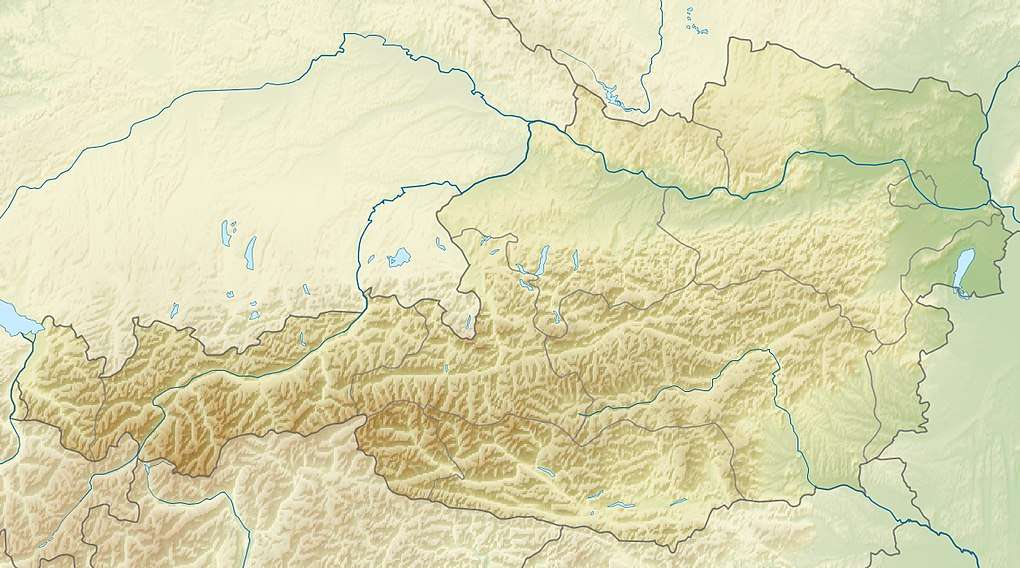
8 Infantry
1 Engineer
1 Cmd Sup
Personnel, conscription, training, and reserves
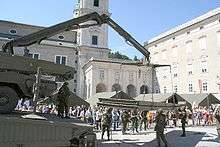
.jpg)

.jpg)
Until 1971 Austrian males were obligated to serve nine months in the armed forces, followed by four days of active service every two years for training and inspection. In 1971 the period of initial service was reduced to six months, followed by a total of sixty days of refresher training in the reserves. In the early 1990s, about 45,000 conscripts completed their initial military training every year, and 80,000 reservists participated in some form of exercises each year.
Reducing the mobilization strength of the army to 120,000 under the New Army Structure plan is to be accomplished in part by limiting initial training of recruits to six months, followed by reducing the period allotted for refresher training from twenty years to ten years. Each reservist is to receive training over a twelve-day period every second year during his first ten years of reserve duty, generally not extending beyond the time he reaches his mid-thirties. The reduced need for conscripts corresponds to a lower pool of young men because of a declining birth rate. The availability of about 40,000 fit trainees annually in 1993 was expected to fall to barely 30,000 by 2000 and to 26,000 by 2015.
In 2006 conscription was reduced to six months total. Mandatory reserve training was abolished. Since then the army reserve battalions (Miliz) are suffering from a lack of new reservists and are therefore overaging.
Under a 1974 law, conscientious objectors can be assigned work as medical orderlies, or other occupations in lieu of military service. Exemptions from service are liberally granted—in 1992 about 12,000 persons were exempted, a great increase over the 1991 total of 4,500. The increase occurred after a new law, valid only for 1992 and 1993, no longer required young men to present their objections to the military in a credible way. Previously, that had not been the case. In 1990, for example, two young men rejected by the alternate service commission on the grounds that they did not present their beliefs in a credible manner were sentenced to prison terms of three months and one month, respectively.
Conscripts may attain the rank of private first class by the completion of initial training. Those with leadership potential may serve a longer period to obtain noncommissioned officer (NCO) status in the militia. Those volunteering for the career service can, after three to four years, apply to attend the NCO academy and later a senior NCO course to qualify as warrant officers. Both regular and militia officer candidates undergo a one-year program of basic training. After a further three years, regular officer candidates attending the military academy at Wiener Neustadt and militia officer candidates undergoing periodic intensified refresher training qualify as second lieutenants. The reserve obligation of conscripts generally ends by the time they reach their mid-thirties; NCOs and officers usually end their reserve status at a later age depending on their rank and specialization. By the early 1990s, some 1.3 million men had completed their initial service and refresher training obligations and had no further active-duty commitment.
The military personnel system is an integral part of a comprehensive civil service system. The nine officer ranks from officer candidate through general correspond to grades I through IX of the civil service system. The highest grade, IX, may be occupied by a section chief (undersecretary), a career ambassador, or a three-star general. A grade VIII position may be held by a departmental counselor, a career minister, or a brigadier general. Salary levels are the same for both civil and military personnel in the equivalent grades, although various allowances may be added, such as flight pay or hazardous-duty pay.

The system of promotion in the Austrian military, which offers no incentive for early retirement, means that the military is top-heavy with senior officers. The New Army Structure, which is intended to result in many fewer active-duty and reserve commands, compounds the difficulty. Personnel changes can be implemented only gradually, as the surplus of officers shrinks by attrition. In 1991, the army had four officers of general rank, fifty-nine at the rank of brigadier general (one star), 155 colonels, and 254 lieutenant colonels. The education of career officers is conducted at the Maria Theresia Military Academy at Wiener Neustadt, forty-five kilometres south of Vienna, which was founded in 1752. Young men who have completed their university entrance requirements are eligible to compete for places. The three-year course graduated 212 students in 1990. At the National Defence Academy in Vienna, which has a curriculum comparable to those of the National Defence University and the Army War College in the United States, operational and troop commanders of field-grade rank study for three years in preparation for general staff and command positions. The NCO school is located at Enns near Linz. Troop schools provide continuous specialized courses for officers and NCOs in artillery, air defence, armour, combat engineering, communications, and the like.
Women have been accepted for service in the Austrian armed forces since 1998. All service branches are open for female volunteers. In a public opinion survey in 1988, about 66 percent of those polled approved of opening the military to voluntary service by women; only nine percent favoured obligatory service.
Appearance
Since 2019 the new service uniform with a six colour camouflage pattern is issued, but the old service uniform in olive is still widespread and will be taken out of service very slowly.[7][8][9] The dress uniform is grey, for formal occasions a white uniform may be worn. The air force uniform is identical, with the addition of wings worn on the right jacket breast—gold for officers and silver for enlisted personnel. Branches of service are identified by beret colours: scarlet for the honour Guard; green for infantry; black for armour; cherry for airborne; and dark blue for quartermaster. Insignia of rank are worn on the jacket lapel of the dress uniform (silver stars on a green or gold shield) and on the epaulets of the field uniform (white, silver or gold stars on an olive drab field).[10][11]
Equipment
The Austrian military has a wide variety of equipment. Recently, Austria has spent considerable amounts of money modernizing its military arsenal. Leopard 2 main battle tanks, Ulan and Pandur infantry fighting vehicles, C-130 Hercules transport planes, S-70 Black Hawk utility helicopters, and Eurofighter Typhoon multi-purpose combat aircraft have been purchased, along with new helicopters to replace the inadequate ones used after the 1999 Galtür Avalanche.
Austria's current equipment includes:
Infantry Equipment
| Name | Origin | Type | Calibre | Quantity | Photo | Notes |
|---|---|---|---|---|---|---|
| Assault rifle & battle rifle | ||||||
| StG 77 | Assault rifle | 5.56×45mm | Service rifle, 3 variants
Sturmgewehr 77 (StG 77), StG 77 A2, StG 77 KPE | |||
| StG 58 | Battle rifle | 7.62×51mm | 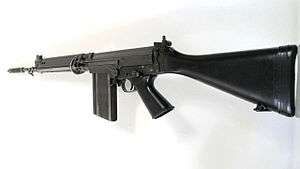 |
Sturmgewehr 58 (StG58). Former service rifle, now used as a ceremonial weapon by Austrian Guard Companies | ||
| Pistol | ||||||
| Glock 17 | Semi-automatic pistol | 9×19mm | .png) |
Pistole 80 (P80), service pistol | ||
| Glock 26 | Semi-automatic pistol | 9×19mm | .jpg) |
|||
| Sniper rifle | ||||||
| Steyr SSG 69 | Sniper rifle | 7.62×51mm | Scharfschützengewehr 69 (SSG69) | |||
| Steyr SSG 08 (M1 variant) | Sniper rifle | .338LM | .jpg) |
SSG M1, fitted with Kahles K624i scope sight, sound suppressor[12][13] | ||
| Machine gun | ||||||
| MG 74 | Machine gun | 7.62×51mm | Maschinengewehr 74 (MG74) | |||
| FN MAG | Machine gun | 7.62×51mm | .jpg) |
Turmdachmaschinengewehr MAG (MAG MG). Only used on Leopard 2A4 tanks, Ulan tanks and Black Hawk helicopters | ||
| üsMG M2 | Machine gun | .50 BMG |  |
Überschweres Maschinengewehr M2 (üsMG M2), heavy machine gun | ||
| Anti-tank weapon | ||||||
| Carl Gustav recoilless rifle | Anti-tank weapon | 84 mm | 1,000[14] | 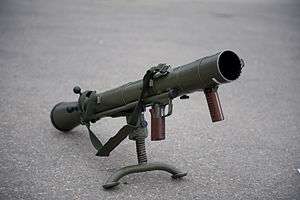 |
Panzerabwehrrohr 66/79 (PAR 66/79) | |
| BILL 1 Anti-tank guided weapon | Anti-tank Weapon | 150 mm | 400[14] | .jpg) |
Panzerabwehrlenkwaffe 2000 (PAL2000) | |
| Grenade launcher | ||||||
| Steyr GL 40 | Grenade launcher | 40 mm | .jpg) |
|||
| mortar | ||||||
| Hirtenberger M6C-210 | 60mm mortar | 60 mm | 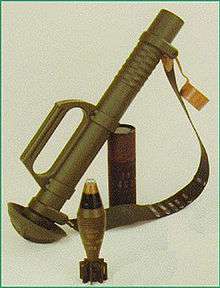 |
|||
| mGrW 82 | 81mm mortar | 81 mm | 100 (est.)[14] |  |
Mittlerer Granatwerfer 82 (mGrW 82) | |
| GrW 86 | 120mm mortar | 120 mm | 200[14] | .jpg) |
Schwerer Granatwerfer 86 (sGrW 86), heavy mortar | |
| Special forces | ||||||
| Steyr TMP | Submachine gun | 9×19mm | 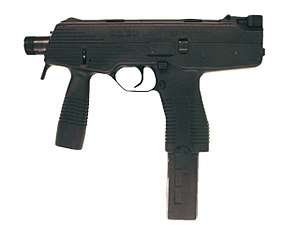 |
|||
| FN P90 | Submachine gun | 5.7×28mm | .jpg) |
|||
| Remington 870 | Pump-action shotgun | 12 gauge | ||||
| Steyr AUG A3 SF | Assault rifle | 5.56×45mm | .jpg) |
|||
| Steyr HS .50 | Anti-materiel rifle | .50 BMG |  |
|||
| Barrett M82 | Anti-materiel rifle | .50 BMG | ||||
| Barrett M95 | Anti-materiel rifle | .50 BMG | 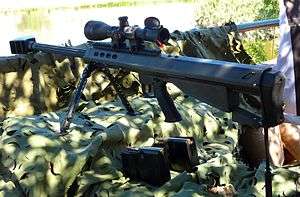 |
|||
Vehicles
| Name | Origin | Type | Number | Photo | Notes |
|---|---|---|---|---|---|
| Armoured vehicle | |||||
| Leopard 2A4 | Main battle tank | 56[14] | _(cropped).jpg) |
Replaced the M60 A3 in 1997[15] | |
| Ulan | Infantry fighting vehicle | 112[14] | Replaced the Schützenpanzer A1 in the mechanized infantry | ||
| Pandur I Pandur EVO |
Armoured personnel carrier | 71[14] 33[16] |
.jpg) |
All Pandur I APCs have been upgraded with a new remote weapon station. Three Pandur I are ambulance APCs. 6 APCs and 1 ambulance APC to be delivered from Belgium from 2016.
1 Pandur EVO to be delivered by 2020 + 30 Pandur EVOs ordered additionally..[16] | |
| Dingo 2 | Infantry mobility vehicle | 75[14] | 60x Dingo 2 ATF (Standard), 12x Dingo 2 AC NBC reconnaissance and 3x Dingo 2 AC ambulance + 40 be delivered from September 2018 | ||
| MAN TGS 38.440 8x8 | Military logistics vehicle | 24 | .jpg) |
||
| Iveco LMV | Light utility vehicle | 172[14] |  |
||
| BvS 10 | Armoured personnel carrier | 32 |  |
First vehicles delivered in 2019 | |
| Armoured recovery vehicle | |||||
| Bergepanzer M 88A1 | Armoured recovery vehicle | 10[14] | |||
| Bergepanzer Greif | Armoured recovery vehicle | 39[14] | .jpg) |
||
| Engineering vehicle | |||||
| Pionierpanzer A1 | Armoured engineering vehicle | 19[14] |  |
||
| Faltstraßengerät | Truck | 13 | 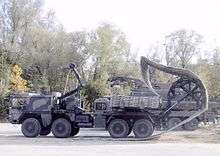 |
Folding-Road Laying System (50m) | |
| Pionierbrücke 2000 | Bridging vehicle | 6 |  |
Dornier Foldable Bridge (40m) | |
| Kaiser Schreitbagger SX | Walking Excavator |  |
|||
| Hydrema 910 MCV-2 | Mine flail | 2[17] | 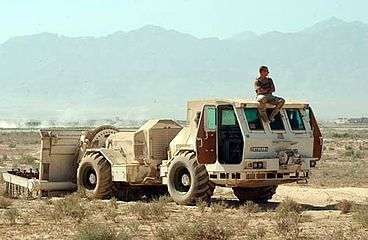 |
In service as Minenräumsystem mittel; for testing[17] | |
| DOK-ING MV-4 | Remote-controlled mine flail |  |
In service as Minenräumsystem leicht[17] | ||
| Marine Alutech Watercat M9 | Transport and rescue boat | 20 | In service as Sturm- und Flachwasserboot | ||
| Unarmoured vehicle | |||||
| Puch G 4x4 | Light utility vehicle | ||||
| Puch G 290/LP "Sandviper" | Special forces vehicle | .jpg) |
|||
| Pinzgauer | Light utility vehicle | ||||
| Mitsubishi Triton | Light utility vehicle | 300 | _GLX-R_4-door_utility_(2007-10-12)_02.jpg) |
||
| Bandvagn 206 | Tracked all-terrain carrier | 1 | .jpg) |
||
| Polaris ATV | All-terrain vehicle | 72 | .jpg) |
To be delivered from 2016 | |
| Unimog | Truck | 268 |  |
||
| MAN TGM 12.240 4×4 BL | Truck | 307 | |||
| Steyr 12 M 18 | Truck | 1,000 | .jpg) |
Basis of the United States Armed Forces FMTV | |
| ÖAF SLKW | Truck | 240 | 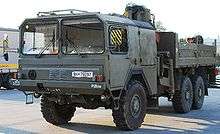 |
||
| Aufklärungs- und Zielzuweisungsradar (AZR) RAC 3D | Truck | 24 | |||
| Artillery & Air-defence | |||||
| M109 A5Ö Rechenstellenpanzer M-109 |
Self-propelled howitzer | 24 9[14][18] |
 |
[19][20] | |
| Zwillingsflugabwehrkanonen 35 mm (ZFLAK 85) | Anti-aircraft gun | 12 | .jpg) |
Reduced from 70 to 12 pieces | |
| Mistral missile | Surface-to-air missile | 34 | .jpg) |
40 in storage | |
Aircraft
| Name | Origin | Type | Number | Photo | Notes | |
|---|---|---|---|---|---|---|
| Fighter Aircraft | ||||||
| Eurofighter Typhoon | Multirole fighter | 15[14] | 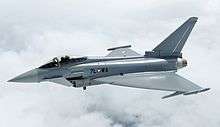 |
To be replaced by 15 new single-seater and 3 two-seater aircraft from 2020 on due to high operating costs | ||
| Transport Aircraft | ||||||
| Lockheed C-130 Hercules | Military transport aircraft | 3[14] | .jpg) |
C-130K | ||
| Pilatus PC-6B Porter | STOL Passenger and Utility aircraft | 8[14] | .jpg) |
|||
| Trainer Aircraft | ||||||
| Saab 105 | Military trainer aircraft | 18[14] | .jpg) |
To be replaced in the near future | ||
| Pilatus PC-7 Turbo Trainer | Military trainer aircraft | 12[14] | .jpg) |
|||
| Diamond DA40 | Military trainer aircraft | 4[21] |  |
4 delivered in 2018 | ||
| Helicopters | ||||||
| Sikorsky UH-60 Black Hawk | Utility helicopter | 9[14] | .jpg) |
3 to be delivered in 2021 | ||
| Bell OH-58 Kiowa | Observation/scout helicopter | 10[14] | .jpg) |
To be replaced in the near future | ||
| Bell 212 Twin Huey | Helicopter | 23[14] | .jpg) |
Made by Agusta, Italy | ||
| Aérospatiale Alouette III | Helicopter | 21[22] |  |
Scheduled to retire in 2020 | ||
| UAVs | ||||||
| EADS Tracker | Unmanned aerial vehicle | 18[14] | ||||
Rank structure
Of the eight enlisted ranks, only a sergeant (Wachtmeister) or above is considered an NCO. There are two warrant officer ranks—Offiziersstellvertreter and Vizeleutnant. The lowest commissioned rank of officer candidate (Fähnrich)—is held by cadets at the military academy and by reserve officers in training for the rank second lieutenant. To maintain conformity with grade levels in the civil service, there are only two ranks of general in the personnel system—brigadier general (one star) and general lieutenant (three stars). However, the ranks of major general (two stars) and full general (equivalent to four stars) are accorded to officers holding particular military commands.[23]
International operations
Currently (June 14, 2016) there are Bundesheer forces in:

- EUFOR Althea (former SFOR)
- 195 personnel
- since 2 December 2004 under European Union Command



- UNIFIL
- 182 personnel

- RACVIAC
- 1 personnel

- EUMM
- 3 personnel
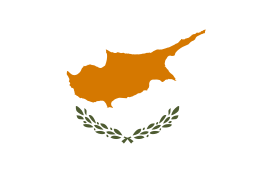
- UNFICYP
- 4 personnel
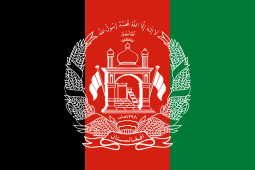
- RSM
- 9 personnel

- EUNAVFOR MED SOPHIA
- 8 personnel

- UNTSO
- 4 personnel

- OSCE
- 1 personnel

- EUMAM/RCA
- 1 personnel

- EUSEC
- 1 personnel

- SMMU
- 10 personnel

- EUTM MLI
- 10 personnel
- MINUSMA
- 6 personnel

- MINURSO
- 5 personnel
Protection of cultural heritage
Cultural property protection has been firmly anchored in the Austrian Armed Forces since 1980.[24] There is intensive cooperation between the Austrian Armed Forces, United Nations, UNESCO and Blue Shield International on the protection of cultural goods. There are national and international assignments and numerous collaborations, including with United Nations peacekeeping. During training as well as at the Theresian Military Academy, intensive reference is made to the protection of cultural property and the international experience of Blue Shield International.[25] In principle, the responsible organizational units of the ministry, the commanders of all management levels, the legal advisers, the officers (military cultural property protection) and the military police have to work together to implement military cultural property protection.[26][27][28][29][30]
Traditions
Some of the traditions of the old Austro-Hungarian Army continue to be carried on in Bundesheer. For example, the most famous regiment in the Bundesheer is the "Hoch und Deutschmeister Regiment", now known as Jägerbataillon Wien 1 based in "Maria Theresien Kaserne", named after Empress Maria Theresa of Austria. Also nearly every other regiment of the Bundesheer carries on traditions of the famous Austro-Hungarian regiments like "Kaiserjäger", "Rainer", etc.
Naval Squadron (1958–2006)
In 1958 the patrol boat RPC Oberst Brecht was commissioned as a naval squadron of the Army to patrol the Danube in protection of the country's neutrality. The larger vessel RPB Niederösterreich was also commissioned 12 years later. The squadron comprised two officers and thirty men. The company which built the vessels closed in 1994. With the fall of Communism and the inability to maintain and repair the vessels, the squadron was disbanded in 2006.[31] Both vessels were donated to the Museum of Military History, Vienna after their decommissioning, and can be toured by museum guests.
Strong Europe Tank Challenge
Austria took first place in the Strong Europe Tank Challenge 2017 as six nations and partner nations battled it out in Grafenwoehr, Germany. The Austrian tankers defeated teams from France, Germany, Poland, Ukraine and from the United States in the exercise.[32] The Austrian soldiers used Leopard 2A4 tanks during the competition.[32]
See also
- Austrian air defence
- Austrian Air Force
- Austrian conscription referendum, 2013
- Austrian Military Police - Kommando Militärstreife & Militärpolizei (Kdo MilStrf&MP)
- Heeresgeschichtliches Museum
- Heeresnachrichtenamt
- Jagdkommando
- Theresian Military Academy
Citations
- IISS 2019, p. 88.
- IISS 2019, p. 89.
- "Organisation - Austrian armed Forces". Ministry of Defence and Sports. Retrieved 2013-08-20.
- Austrian Mission to NATO
- http://lcweb2.loc.gov/cgi-bin/query/r?frd/cstdy:@field%28DOCID+at0157%29 which quotes "Jane's Defence Weekly [London], 17, No. 4, January 24, 1992, 117-24. "
- Archived 2017-03-17 at the Wayback Machine
- http://www.bundesheer.at/cms/artikel.php?ID=9906
- https://kurier.at/politik/inland/neue-tarnuniformen-ab-heute-ist-bundesheer-in-camouflage-look-im-einsatz/400424153
- https://www.spartanat.com/2019/03/oesterreich-neue-tarnuniformen-ab-2018/
- BMLVS - Abteilung Kommunikation. "Bundesheer - Uniformen und Abzeichen - Barettfarben". Retrieved 24 December 2014.
- BMLVS - Abteilung Kommunikation. "Bundesheer - Uniformen und Abzeichen - Dienstgrade". Retrieved 24 December 2014.
- SSG M1 - STEYR ARMS
- Austrian Special Forces receive Sniper Rifles _ Jane's 360
- "heute.at (Austrian Newspaper)". Archived from the original on 2013-01-25.
- "Archived copy". Archived from the original on 2016-03-04. Retrieved 2015-01-07.CS1 maint: archived copy as title (link)
- "Fünf von 34 neuen Pandur-Panzern an Heer in Steiermark übergeben". diepresse.com (in German). 14 January 2019.
- "NATIONALFEIERTAG 2017 | DOPPELADLER.COM". www.doppeladler.com. Retrieved 2017-10-29.
- "ARMOUR FOCUS – NEW LATVIAN M109 SPH". joint-forces.com. 4 April 2018.
- "Panzerhaubitze M-109 A5Ö". bundesheer.at (in German).
- "Rechenstellenpanzer M-109". bundesheer.at (in German).
- http://www.bundesheer.at/cms/artikel.php?ID=9456
- "Archived copy". Archived from the original on 2019-01-25. Retrieved 2019-02-01.CS1 maint: archived copy as title (link)
- Archived 2017-03-17 at the Wayback Machine
- Schutz des kulturellen Erbes (German - Protection of cultural heritgage), Austrian Armed Forces
- Lecture by Karl von Habsburg-Lorraine: The role of the military in the protection of cultural assets (2019).
- The military protection of cultural assets and the military preservation of cultural heritage, Colonel Dominik Horn
- Military cultural property protection (2016), Colonel Dominik Horn
- Hubert Speckner "Gesamtstaatliches Krisenmanagement am Beispiel Kulturgüterschutz - Herausforderung für kleinere Staaten" in "Internationales Krisen- und Konfliktmanagement 2.0", April 2014.
- "Austrian Armed Forces Mission in Lebanon" (in German).
- UNESCO Director-General calls for stronger cooperation for heritage protection at the Blue Shield International General Assembly. UNESCO, 13 September 2017.
- Eger (2006)
- https://www.army.mil/article/187584/
References
- IISS (2019). The Military Balance 2019. Routledge. ISBN 978-1857439885.
General
![]()
- CIA World Factbook, 2005
- Christopher Eger, The Final End of the Austrian Navy, on the site militaryhistory.suite101.com, 2006
External links
| Wikimedia Commons has media related to Bundesheer. |

